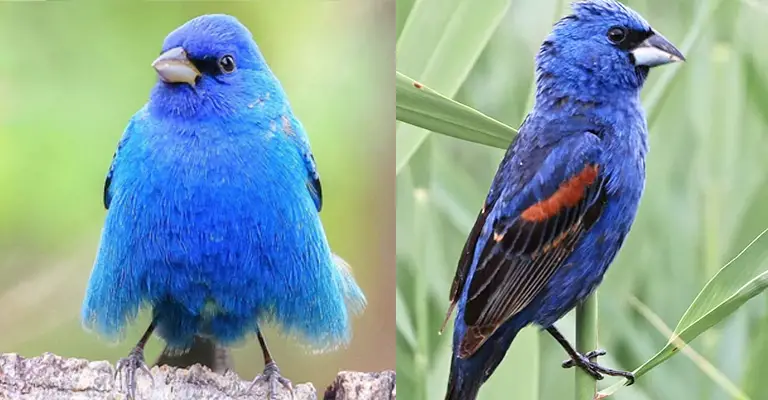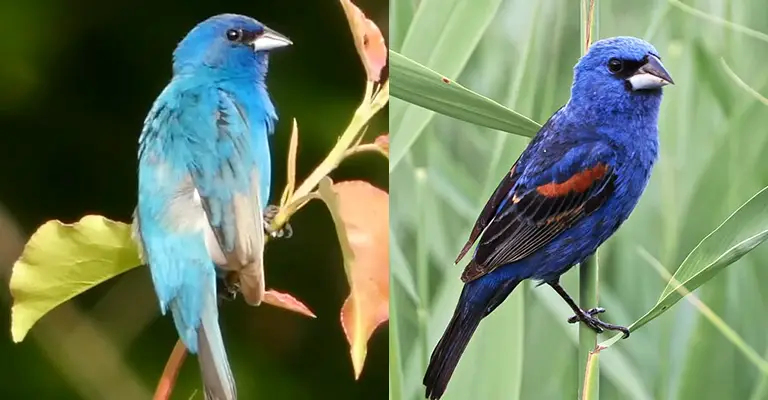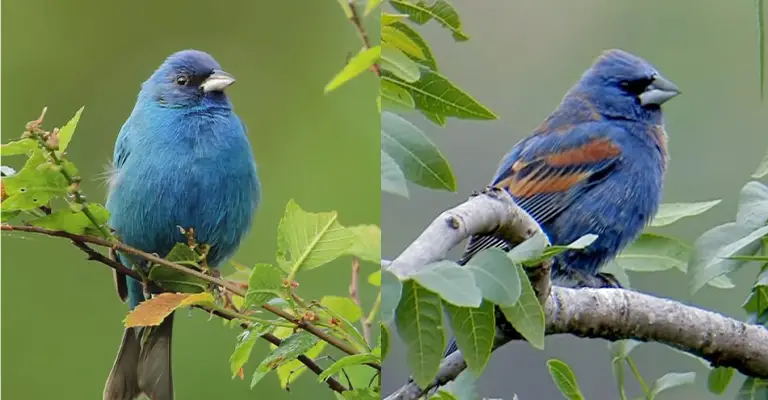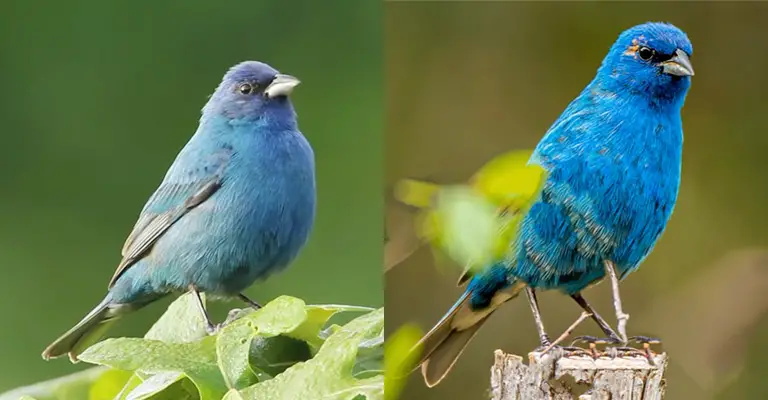In the world of birds, the Indigo Bunting and Blue Grosbeak stand out for their vibrant blue plumage and captivating presence. While sharing some similarities, these species possess distinct characteristics that allow for their differentiation.
Exploring their physical features, behaviors, and habitats sheds light on their individual uniqueness. This is essential if you want to know about them or have any intention to pet either of them in the long run.
This discussion will put light on some of the common and unique traits of both species of birds in a nutshell.

Physical Characteristics
It is important to shed light on the physical qualities of both of the bird species before moving on to any other comparisons. Let’s check them out.
Size and Body Structure
One of the key differences between the Blue Grosbeak and the Indigo Bunting lies in their size and body structure. The Blue Grosbeak is notably larger in size compared to its counterpart, the Indigo Bunting.
With a robust build, the Blue Grosbeak commands a more substantial presence. In addition to their size, their bills also differ. The Blue Grosbeak boasts a heavier bill, designed for cracking open seeds and consuming larger insects.
On the other hand, the Indigo Bunting possesses a smaller, more delicate bill, suited for foraging on smaller seeds and insects.
Plumage Differences

The male Indigo Bunting and male Blue Grosbeak both exhibit stunning blue plumage, but upon closer inspection, there are noticeable distinctions. The male Indigo Bunting showcases a deep, intense blue coloration throughout its body, captivating observers with its vibrant hue.
In contrast, the male Blue Grosbeak tends to display a lighter or more turquoise blue shade, which can give it a slightly different appearance under certain lighting conditions.
When it comes to the female and immature birds, the plumage differences become more apparent. The female and immature Indigo Buntings feature primarily brown feathers, with lighter underparts.
Their wing bars also tend to be lighter in color, providing a subtle contrast to the overall brown plumage. On the other hand, the female and immature Blue Grosbeaks exhibit a richer buffy brown coloration, giving them a warm and earthy appearance.
Their wing bars, in contrast, are darker, creating a more pronounced contrast against the brown plumage.
By paying attention to size, bill shape, and variations in coloration, observers can confidently differentiate between the Blue Grosbeak and the Indigo Bunting, enhancing their birdwatching experiences and appreciation for the diversity of avian species.
Behavior and Habitat

Both of the birds have some unique feathers and behavioral patterns towards life and habitat selection. Try to go through them to know further.
Similarities in Behavior and Habitat Preferences
Both the Indigo Bunting and Blue Grosbeak share certain behavioral traits and habitat preferences. For instance, both species are known for their melodious songs, which they use to establish territories and attract mates during the breeding season.
They are also primarily insectivorous, feeding on a wide range of insects, including beetles, grasshoppers, and caterpillars. In terms of habitat, both birds exhibit a preference for open areas with ample shrubs and vegetation where they can forage and nest.
Unique Behaviors or Preferences of Each Species
While there are shared characteristics, the Indigo Bunting and Blue Grosbeak also have distinct behaviors and preferences that set them apart.
Indigo Bunting
The Indigo Bunting is known for its migratory patterns. These birds undertake long-distance migrations, traveling from their breeding grounds in North America to their wintering grounds in Central and South America.
Their journey covers thousands of miles, and they navigate using various cues, including celestial navigation and environmental landmarks.
In terms of habitat, Indigo Buntings are often found in brushy areas, woodland edges, and forest clearings. They have a preference for habitats with dense vegetation and access to water sources.
During the breeding season, males establish territories and defend them vigorously through their vibrant songs and displays.
Blue Grosbeak
Blue Grosbeaks, on the other hand, exhibit different behaviors and nesting preferences. They are known for their unique nesting behaviors, often choosing dense shrubs or thickets as nesting sites.
Males actively participate in nest construction, helping to build intricate cup-shaped nests using grasses, leaves, and other plant materials.
For foraging, Blue Grosbeaks have a diverse diet that includes seeds, berries, and insects. They are skilled at capturing insects in mid-air, showcasing their agile flight abilities.
These birds are also known for their preference for open habitats, such as grasslands, prairies, and agricultural fields, where they can find a variety of food sources.
Tips to Identify Indigo Bunting and Blue Grosbeak

One should keep in mind some of the tips on the identification of these two types of birds. Check out the following section.
Size Comparison and Bill Shape
One of the key identification cues is comparing the size and bill shape of the birds. Blue Grosbeaks are generally larger than Indigo Buntings, with a more robust body structure.
When observing them side by side, the size difference becomes apparent. Additionally, paying attention to their bills is crucial. Blue Grosbeaks have a heavier bill, while Indigo Buntings possess a smaller, more delicate bill.
Comparing these features can help differentiate between the two species, especially when size and bill shape are observable.
Plumage Characteristics and Color Variations
Plumage characteristics and color variations play a significant role in distinguishing between the Indigo Bunting and Blue Grosbeak. For male birds, the intensity and shade of blue are crucial factors.
Male Indigo Buntings exhibit a deep, intense blue coloration, while male Blue Grosbeaks often display a lighter or more turquoise blue hue. Examining the shades of blue can provide valuable insights into their identities.
For female and immature birds, plumage differences become more pronounced. Female and immature Indigo Buntings primarily exhibit brown feathers with lighter underparts and wing bars.
In contrast, female and immature Blue Grosbeaks have a richer buffy brown coloration overall, with darker wing bars. Observing these plumage characteristics, particularly the coloration and wing bar patterns, can help identify the species accurately.
Observing Behavior, Habitat, and Vocalizations
Behavior, habitat preferences, and vocalizations are essential factors in identification. Both species have unique behaviors and habitat choices. Observing their behaviors, such as courtship displays or foraging techniques, can provide additional insights.
Indigo Buntings’ migratory patterns and preference for brushy areas and woodland edges can differentiate them from Blue Grosbeaks, which often select open habitats like grasslands and agricultural fields.
Vocalizations are also valuable identification cues. Indigo Buntings have a distinctive song, characterized by a series of melodious, high-pitched notes.
Blue Grosbeaks, on the other hand, produce a varied song with a mix of musical phrases. Familiarizing oneself with their vocalizations can aid in distinguishing between the two species.
Case Study: Baldwin County, Alabama

Please go through the following case study to know more about these two types of birds on the basis of research data.
The Observed Bird
The case begins with an observation of a bird in Baldwin County, Alabama. While the exact details of the observation are not provided, it is important to note the general characteristics of the observed bird, such as its size, plumage, and behavior.
These details form the foundation for the identification process.
Initial Identification as a Blue Grosbeak
Based on the field observations, the bird was initially identified as a Blue Grosbeak. This identification could have been influenced by certain observable features, such as the size, plumage coloration, or habitat preference of the bird.
The observer may have noted the larger size and heavier bill of the bird, along with other physical characteristics that aligned with the known attributes of a Blue Grosbeak.
Breast Streaking and Doubts About the Identification
Upon further examination, the observer noticed the presence of breast streaking on the bird. Breast streaking refers to thin, dark lines or streaks visible on the breast area of the bird’s plumage.
This observation led to doubts about the initial identification as a Blue Grosbeak. Breast streaking is not a typical feature of Blue Grosbeaks but can be present in other species, such as the Indigo Bunting.
When to Seek Expert Advice
This case highlights the significance of considering multiple factors when identifying bird species. While initial observations may point towards a particular species, it is essential to assess various aspects, including size, bill shape, plumage characteristics, and behavior.
In this case, the presence of breast streaking challenged the initial identification. To resolve the confusion and make an accurate identification, seeking expert advice or consulting field guides can be beneficial.
Ornithologists, experienced birdwatchers, or online birding communities can provide valuable insights and help confirm the identification.
This case study emphasizes the importance of being open to reevaluating initial identifications and considering multiple factors before reaching a conclusion.
It highlights the value of expert knowledge and collaboration within the birding community to ensure accurate identification and expand our understanding of bird species.
Comparison At A Glance: Indigo Bunting Vs. Blue Grosbeak
| Characteristic | Indigo Bunting | Blue Grosbeak |
| Size | Smaller | Larger |
| Bill Shape | Delicate | Heavier |
| Male Plumage Color | Deep, intense blue | Lighter or more turquoise blue |
| Female/Immature Plumage Color | Primarily brown with lighter underparts | Richer buffy brown with darker wing bars |
| Breast Streaking | Absent | Possible presence |
| Habitat Preferences | Brushy areas, woodland edges | Open habitats, grasslands |
| Migratory Patterns | Long-distance migration | Non-migratory |
| Nesting Behavior | Notable nest builders | Nests in dense shrubs or thickets |
| Foraging Habits | Primarily insectivorous | Insects, seeds, berries |
| Vocalizations | Melodious high-pitched song | A varied mix of musical phrases |
| Territory Defense | Vocal displays, aggression | Vocal displays, aggression |
| Nest Construction | Cup-shaped nests in trees | Cup-shaped nests in shrubs |
| Preferred Water Sources | Lakes, streams, and wetlands | Puddles, shallow water sources |
| Range | Eastern and Central North America | Southern and Southwestern United States |
| Conservation Status | Least Concern | Least Concern |
FAQs
The male Indigo Bunting’s song consists of a series of melodious, high-pitched notes, often described as a jumbled or accelerating song pattern. In contrast, the male Blue Grosbeak produces a more varied song with a mix of musical phrases, including clear whistled notes and buzzy or trilled elements.
Familiarizing yourself with their unique songs can help distinguish between the two species.
Yes, there is some overlap in the geographic distribution of Indigo Buntings and Blue Grosbeaks. Both species can be found in certain regions of North America during the breeding season.
However, their specific habitat preferences within those regions may differ, as Indigo Buntings tend to favor brushy areas and woodland edges, while Blue Grosbeaks are more commonly found in open habitats such as grasslands and agricultural fields.
While Indigo Buntings and Blue Grosbeaks may occur in the same general habitat, they are not typically observed together in mixed-species flocks. These species tend to maintain separate territories and exhibit different social behaviors during the breeding season.
However, in certain areas where their ranges overlap, it is possible to encounter them in proximity to each other, though they may not actively interact or form cohesive flocks.
Female Indigo Buntings and Blue Grosbeaks can have similar brown plumage, making it challenging to differentiate them based solely on their appearance.
However, paying attention to subtle differences in plumage can provide some clues. Female Indigo Buntings generally have lighter underparts and wing bars compared to female Blue Grosbeaks, whose plumage tends to be richer and more buffy brown overall, with darker wing bars.
Additional identification cues, such as behavior, habitat preference, and vocalizations, can aid in accurate identification.
Conclusion
The Indigo Bunting and Blue Grosbeak are two beautiful bird species with distinct characteristics. Their size, bill shape, plumage colors, habitat preferences, and behaviors provide valuable cues for identification.
By considering these factors, observing their songs, and seeking expert advice when needed, bird enthusiasts can successfully differentiate between these species and appreciate their unique qualities.
Now let us if you have any more questions in this regard. Aksi share your thought about it with us in the comment section. Thank you for your time.